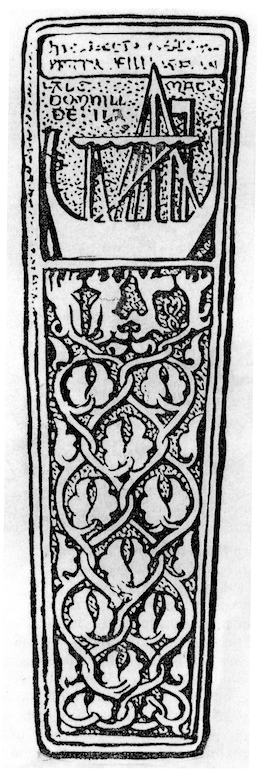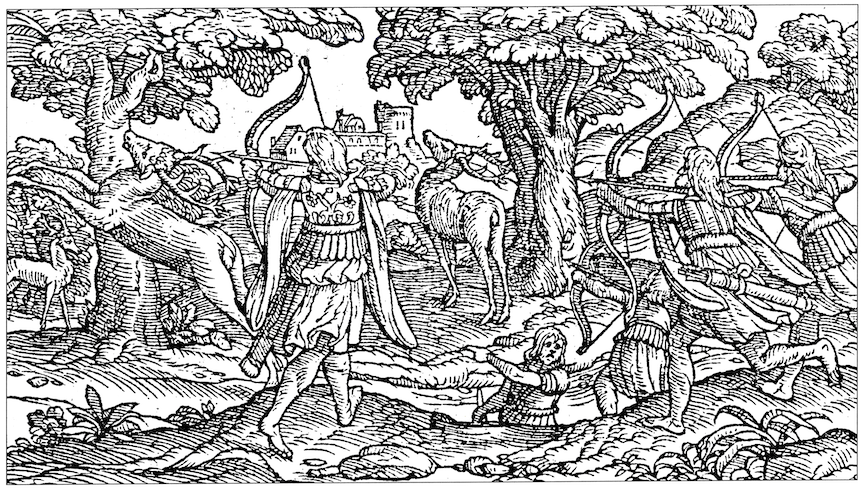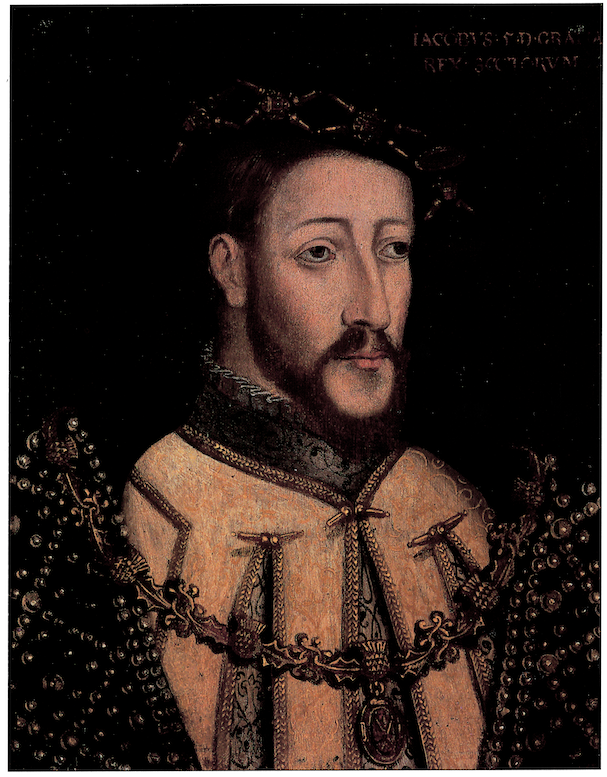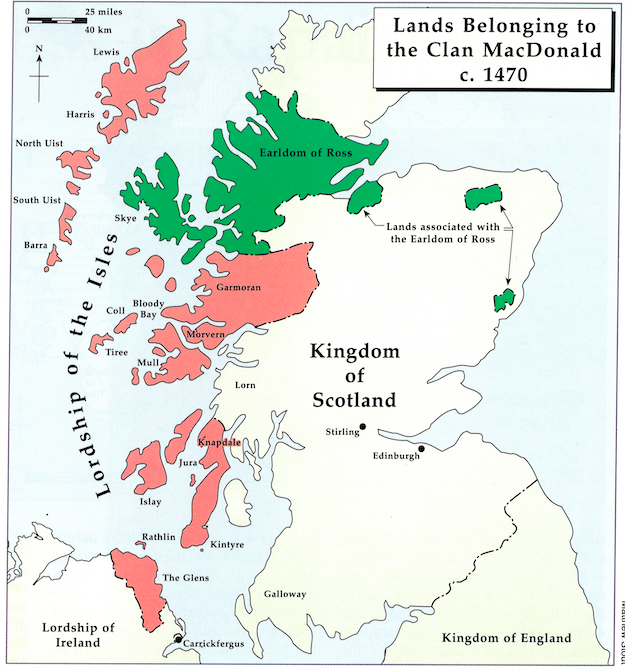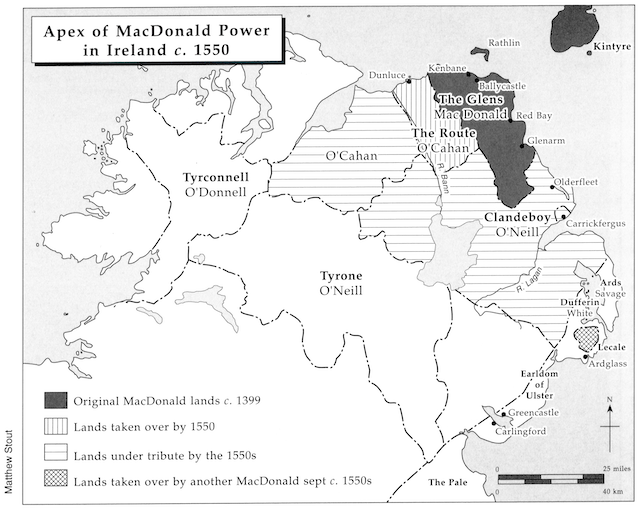During the later middle ages the Gaelic-speaking regions of Ireland and Scotland witnessed a revival in influence. In Ireland, the decline of Anglo-Norman power in the mid-fourteenth century facilitated a partial indigenous ‘reconquest’, whilst in Scotland the Hebridean population escaped Norse rule to maintain a degree of autonomy within the kingdom of Scotland.
At the forefront of the Gaelic revival in Scotland was the Clan Donald or MacDonalds, a family whose ‘Lordship of the Isles’ grew to such an extent in terms of size and military strength that at its height it encompassed the whole of the Hebrides, a large section of the northern highlands and part of Ulster too. As a consequence the MacDonalds not only came to play an expanding role within the affairs of the ‘Celtic’ fringe, but were increasingly drawn into the wider political affairs of Ireland, Scotland and England.
The rise of the MacDonalds
The MacDonalds were descended from Somerled of Argyll who in the mid-twelfth century ousted the Norse from overlordship of the southern Hebrides, a consequence of Viking settlement over the previous three centuries. Upon Somerled’s death c. 1165, his lands were divided amongst his sons in Gaelic fashion; in 1266 when Alexander III of Scotland ended the remnant of Norse rule in the Isles, the territories of the three major clans descended from Somerled—the MacDougalls, the MacRuairis and the MacDonalds—were incorporated within the Scots realm. This was to have an important effect upon the Gaelic west. Since the early twelfth century, the Scots kingdom had assimilated many aspects of Norman and continental society. The Gaelic tongue was superseded by Scots English. Scotland was transformed into a feudal kingdom, where practices such as primogeniture and the issue of charters of enfeoffment gradually replaced Gaelic usages such as tanistry. After 1266, although the highlands and islands remained Gaelic-speaking, elements of feudal society were introduced from eastern and lowland Scotland.
‘Lord of the Isles’
The MacDonalds in particular benefited and by the middle of the fourteenth century they acquired the lands of the two other major Clans in the Isles through feudal means—the MacDougalls’ by royal grant and the MacRuairis’ after that family died out in the male line and the chief of the MacDonalds married the female heiress. The practice of primogeniture also became the norm amongst the Clan Donald, thus confining the headship of the family to one direct male line. By the 1330s at least, he began to issue (mainly) Latin charters of enfeoffment to the cadet families of the clan, styling himself ‘Dominus Insularum’ or Lord of the Isles. By the mid 1300s, therefore, the head of the Clan Donald, John, had adopted those measures prevalent within the rest of Scotland and in so doing had secured a position of dom-inance within the Isles. But in many respects John remained a Gaelic lord in that his position ultimately rested upon his ability to command the support of his kinsmen. His ‘Lordship of the Isles’ was, therefore, a hybrid. This distinguished it from the Gaelic lordships of Ireland, where dependence on strength alone created greater instability and smaller lordships.
The Glens of Antrim
The MacDonalds willingness to employ ‘feudal’ means to extend their territory also allowed a branch of the family to establish itself in Ireland when John (Ian) Mór, a younge; brother of Donald, the second Lord of the Isles, married the heiress to the Glens of Antrim, Margery Bisset, in the 1390s. The Glens were part of the Anglo-Norman earldom of Ulster and had been in the possession of the Bissets since the 1250s. The earldom of Ulster had never been as densely settled as other Anglo-Norman areas in Leinster and Munster and during the fourteenth century had been weakened by the Bruce invasion. Many settlers such as the Savages of the Ards adopted the ways and speech of the indigenous population and large sections of the earldom itself were taken over by expanding Gaelic dynasties such as the O’Neills of Clandeboy. There was little the government in Dublin could do to halt these developments. In theory the arrival in the area of the MacDonalds, subjects of England’s rival Scotland, should have added to the Dublin administration’s worries. In fact this was not the case. In the process of accumulating land and power in the Hebrides during the 1300s, John, first Lord of the Isles, had strained the relationship between himself and the Scots monarchy. This mistrust stemmed partly from the fact that for a time during the 1330s John MacDonald had supported an (ultimately unsuccessful) English bid for the Scots throne. The English realised that the Lordship of the Isles, though a farflung region on the north-western fringe of Britain, had a formidable military and naval capacity. John Mór’s acquisition of the Glens and Rathlin was welcomed, therefore, and at the same time reawakened English interest in the MacDonalds. Both King Richard II of England (who visited Ireland twice in the 1390s) and his successor King Henry IV acknowledged John Mór’s legitimate feudal claim to these lands and may have viewed him as an ally, not only to assist control Scotland, but also to overawe the recalcitrant nobles of Ulster and restore English fortunes there. From the 1390s onwards, therefore, John Mór and his descendants (Clan Ian Mór) acted as agents between the English crown and the Lord of the Isles and became embroiled in the ongoing Anglo-Scottish conflict.
This role was maintained throughout the fifteenth century, as the relationship between the Lordship of the Isles and the Scots government deteriorated even further. In 1462, King Edward IV of England, eager to deal with Scotland once and for all, involved the head of the Clan Ian Mór, Donald (son of John Mór) and John, the fourth Lord of the Isles, in an ambitious scheme by which all three, along with the exiled Scottish Earl of Douglas, would invade Scotland and carve up the country between them. Though this scheme was soon abandoned, King Edward again attempted to gain the active support of the Clan Ian Mór for another invasion of Scotland in 1480 and was in communication with John (Donald’s son and successor as head of Clan Ian Mór). Although nothing appears to have come of this plan either, both episodes show how the Clan Ian Mór remained a significant element in English strategy.
The state within a state
So long as England and Scotland remained rivals, and so long as the MacDonalds remained powerful, it followed that the English crown would continue in its attempts to enlist their support. In the last years of the fifteenth century, however, this situation began to change. The continued growth of the Lordship of the Isles during the fourteenth and first half of the fifteenth centuries was helped by the weakness of the Scots monarchy. Under King James III (1460-88) and especially King James IV (1488-1513), the monarchy began to recover and consequently greater pressure was put on the Lord of the Isles. In 1476, when details of the 1462 plot with England became known, John Lord of the Isles was accused of treason and forced to give up the earldom of Ross (which his father Alexander had finally gained in the 1430s) along with Kintyre and Knapdale. The further expansion of the MacDonalds within Scotland was checked and, as a result, John’s position came under attack from his own MacDonald kinsmen. Disorder within the Isles increased. In an attempt to restore order in 1493, James IV deposed him and declared the Isles forfeit. As for the many cadet branches of the Clan Donald, King James was willing to regrant their lands as long as they accepted royal authority. But in 1494 when the Clan Ian Mór openly rejected James’s plans, the family’s lands were swiftly confiscated and its leading members declared traitors.
Interlopers
Prior to this, there was little evidence of widespread migration from the Isles to the Glens and Rathlin. With disorder throughout the Hebrides after the 1470s and the imposition of Scottish royal control, however, many thousands fled to Ireland. Coupled with the knowledge that the Lordship of the Isles was no more and that the Clan Ian Mór were no longer useful allies, this brought a shift in attitude by the English crown towards the MacDonald presence in Ulster. In addition its officials in Dublin were influenced by the emergence of a ‘reform’ group within the Irish government who advocated the greater anglicisation of the country and the ejection of outsiders. The Clan Ian Mór’s legitimate feudal title was deliberately ignored, as was its previous pro-English policy. From the 1490s onwards the MacDonalds in the North were looked upon by Dublin as interlopers, Scottish agents and the fifth column to a Scottish invasion on the scale of 1315.
Despite these fears the Irish government did not have the resources to deal with the MacDonalds. As the volume of settlers increased, Hebridean groupings were to be found in ever greater numbers outside of the Glens in Clandeboy and the Mac Quillan lordship of the Route beyond the River Bann. By the opening decades of the sixteenth century, the Clan Ian Mór exercised increasing control in these areas.
The fact that the Clan Ian Mór was forced to consolidate and expand its lands in Ireland did not mean that all hope had been given up of retrieving the family’s Hebridean territories. The head of the Clan, Alexander MacDonald, played a prominent part in the prolonged revolt in the Isles which followed the death of James IV in 1513. This culminated in 1520 in the return of some of the forfeited lands and a lessening of tension between the Clan Ian Mór and the Scots government, now in the hands of a regency council as James V was a minor.
James V’s Irish intrigue
In 1528 James came of age and assumed the reins of power. In an attempt to distance himself from the policies of the regency, he declared all grants made to the island lords null and void. His real target was the main government supporter in the west, the Earl of Argyll, Colin Campbell, whom the king suspected of gaining from the decline of the Clan Donald to transform himself into a new ‘Lord of the Isles’. The immediate outcome was another MacDonald revolt. The conduct of Argyll during the course of the rising appeared to bear out James’s fears and as a consequence the king decided to dispense with Campbell support and appease the MacDonalds. Thus by 1531 Alexander MacDonald regained most of his family’s former lands in Kintyre and Islay and replaced Argyll as the main royal agent in the southern Isles.
This was a revolutionary occurrence. For almost two centuries relations between successive kings of Scots and the leadership of the MacDonalds had been, to say the least, tense. But now King James V had come to terms with Alexander, chief of the Clan Ian Mór and de facto head of the Clan Donald. Once again the Clan Ian Mór found itself embroiled in Anglo-Scottish rivalry, this time on the Scottish side.
Prior to the 1530s Scots kings had maintained a residual interest in Ireland. Ever since the Bruce invasion of 1315, they viewed Ireland as the English crown’s weakest point but were not in a strong enough position, nor offered an opportunity, to exploit this. Nevertheless contacts were maintained with Irish lords. King James IV developed a particularly friendly relationship with the O’Donnells of Tyrconnell, and both Hugh Roe O’Donnell and his son Hugh Dubh paid visits to Scotland. In 1513, when James IV was planning to attack England (which ended in disaster at Flodden), he gave his ally O’Donnell men and munitions to spread the conflict against English positions in Ireland. O’Donnell, however, backed out of the plan at the last moment and sailed home, leaving both soldiers and artillery behind.
Despite this the idea of employing an Irish or Irish-based lord to exploit English problems rather than direct Scottish intervention on the scale of the Bruces prevailed after 1513. By the 1530s, James V’s newly-formed alliance with Clan Ian Mór provided the means.
From 1531 onwards, James V encouraged Alexander MacDonald to further expand the influence of the Clan Ian Mór within Ulster. In 1532 it was reported to the Irish government that ‘the Scottes kyng hath sent fyve hundreth archers frome the owte isles of Scotland unto the said Machonnell [MacDonald] in great hast’, whilst Alexander himself had ‘gone over in to Ireland with the nombre of 7,000 men … and it is said hath done myche harme’. This build-up of Hebridean strength continued for the next couple of years and rumours abounded that, his pathway cleared by the MacDonalds, King James would personally cross the North Channel at the head of a Scottish army.
The Geraldine revolt
These fears became even more acute after the rebellion of the Earl of Kildare’s son ‘Silken’ Thomas in 1534. The subsequent introduction of King Henry VIII’s governmental and religious reforms into Ireland succeeded in alienating sections of the Irish nobility. James increasingly styled himself as the champion of the true faith and his MacDonald allies began to act alongside the two major lords of Ulster—Con O’Neill of Tyrone and Hugh Dubh O’Donnell of Tyrconnell and his son Manus. In 1537 Con O’Neill married a kinswoman of Alexander MacDonald and was said to possess ‘a grete power of both Irishmen and Scottes’. Manus O’Donnell (who succeeded his father in the same year) was in constant contact with James requesting men and artillery.
Meanwhile the power of the Clan Ian Mór in eastern Ulster grew and by 1538 there were Hebridean settlements in Down where the in-comers had displaced the Savages. As ever the Irish government lacked the resources to banish the MacDonalds: even though Dublin continually pestered King Henry and his ministers for ships to guard the North Channel and disrupt Hebridean lines of communication, little was forthcoming. In late 1538, an expedition led by Henry VIII’s deputy in Ireland, Lord Leonard Grey, did attempt to dislodge the settlements in Down but success was short-lived and the settlers simply moved back as the expedition returned southwards.
Invasion aborted
By the beginning of 1539, rumours of invasion abounded. In March, Thomas Wusle, the constable of Carrickfergus castle, reported that the king of Scots planned to send a further 6,000 ‘redshankes [Hebridean soldiers 1 to give the king’s officers in Ireland a field’ and that James had been in touch with the MacDonalds in Ireland at the start of the year. By summer it was expected that King James and a Hebridean army of many thousands would join up with those in Ireland who opposed Henry VIII’s religious changes and his treatment of the Lordship of Ireland Lands associated with the Earldom of Ross Kingdom of Scotland Stirling- House of Kildare, notably Kingdom of England O’Neill and O’Donnell. Further rumour suggested that this was to take place in conjunction with an invasion of England by the Emperor and the king of France. In August Ulster finally stirred. The MacDonalds, along with some other nobles from Scotland, joined up with O’Neill and O’Donnell. The combined force, said to have been the largest ever assembled on Irish soil, marched southwards into Leinster and attacked the Pale, burning Navan and Ardee, destroying corn and carrying off large amounts of cattle. The raid was designed to weaken the Pale’s defences as a prelude to the arrival of James with additional soldiers. Whilst at camp at Bellahoe, near Carrickmacross, the raiding army was surprised by Lord Deputy Grey and completely routed. King James’s invasion plans were put on hold.
The events of August 1539 shook James V’s resolve as regards Ireland. His attitude towards the MacDonalds shifted. In that same year, a revolt had taken place in the northern Isles and there had been feuding between families related to the Clan Ian Mór in the south, underlining the shortcomings of a policy which relied on the MacDonalds to keep order themselves. Between 1540 and his death in late 1542, therefore, James pursued a much tougher policy towards the Isles and, among other measures, garrisoned two castles belonging to the Clan Ian Mór. Relations between the Clan and the Scots government cooled.
Shifting allegiances
Upon the death of James V, Scottish government again passed into the hands of a regency council which was too preoccupied with other matters to show any interest in Ireland. In this atmosphere, and because of the soured relations in James V’s final years, the MacDonalds in Ulster attempted to distance themselves from Scotland and, in order to preserve their territories, court favour with Henry VIII. In 1546, the chief of the Clan Ian Mór, James MacDonald (who had succeeded his father Alexander some years earlier) wrote to Henry, stating that he was willing to do the king service. But Henry did not reply, chiefly because of James’s connections with Scotland and the fact that the MacDonalds were continuing to overrun much of eastern Ulster. In 1552 James again appealed to the English crown, this time emphasising his family’s legitimate feudal claim to the Glens, but, hoping that the Hebrideans might eventually be ejected altogether, the Irish government informed Edward VI that this claim was false and that James and his followers had no right to be in Ireland.
James MacDonald was a victim of his family’s past. Since the arrival of the Clan Ian Mór in Ireland, the family had been caught up in the struggle between England and Scotland, first on the English side and then on the Scottish side. To secure his lands in Ireland in the face of mounting opposition from the English crown’s Irish ministers, James broke with tradition and attempted to court the Dublin government whilst not breaking with that of Scotland so as to preserve what lands he held in the Isles. In the light of continuing Anglo-Scottish animosity, of his father’s recent alliancewith James V and of his own followers’ rapid take-over of areas outside of the Glens to which they had no right, there was little likelihood of the Irish government listening to any of his petitions. On the contrary, the Irish government adopted a hard-line approach and on three notable occasions—1551 , 1556 and 1558—attempted military action to rid Ulster of James and his people. All these expeditions failed and both sides became locked in a stalemate.
Shane O’Neill
A window of opportunity opened for both sides in the later 1550s in the unlikely form of Shane O’Neill of Tyrone. By 1559, Shane had emerged as the most powerful lord in the north of Ireland. Harbouring hopes of one day making himself sole ruler of the whole of Ulster, he regarded the Hebrideans in particular as the archusurpers of his perceived rights. Thus both Dublin and James MacDonald had reason to fear him. In the face of this common enemy who was in the process of subduing much of the north, James wrote to Queen Elizabeth I in 1559 expressing his wish to do dutiful service against Shane in return for confirmation of his title to the Glens. The crown, desperate for support against Shane and his destabilising ambitions, was willing to appease James with promises.
During the early 1560s, letters patent were actually prepared by the crown confirming him in his lands. However, there were still those within the Irish government who feared such a move and who hoped that in the long term Shane O’Neill might be induced to remain peaceable. By 1563 this opinion had gained ground. Dublin changed tack and made peace with the lord of Tyrone with the intention of giving him a free hand against the Clan Ian Mór. In early 1564, Shane moved to rid Ulster of the Clan Ian Mór and defeated them the following year at Glenshesk. James MacDonald himself was killed in the battle.
Comprehensive though this defeat was, the MacDonald grip on the Glens and much of the surrounding lands was only temporarily loosened. In fact, Shane O’Neill was the ultimate loser as MacDonald resolve stiffened and proved instrumental in Shane’s demise two years later. But because Shane’s own power was transitory, the Irish government were once again thrown back upon their own devices and forced to deal with the MacDonalds themselves. Their own devices proved at best inept and at worst, as with Essex’s plantation scheme and massacre on Rathlin Island in 1575, particularly savage and counterproductive. By the mid 1580s, Dublin was no closer to achieving its aims.
Treaty of Amity
The wider sphere of AngloScottish rivalry was to prove decisive in shaping the destiny of the MacDonalds’ Irish territories. The Irish government’s objection to the Clan Ian Mor’s presence in Ulster had been founded on the idea that it represented the interests of Scotland and was part of a wider plan for a Scots invasion. Though this had indeed been the case during the reign of James V, it had fallen into abeyance after 1542, and the MacDonalds had subsequently attempted to distance themselves from Scottish intentions. Moreover, after the ‘Protestant Revolution’ in Scotland in 1559/60, relations with England, a fellow Protestant kingdom, became less hostile. In these new conditions the Irish government’s objections to the Clan Ian Mór were increasingly ill-founded, disproportionate and anachronistic. Thus the 1586 treaty of amity between England and Scotland signed at Berwick included an article acknowledging the right of the Clan Ian Mór to remain in Ireland and confirmed them in their lands. The family and its adherents, who for so long had been caught in the crossfire of Anglo-Scottish rivalry, and had been employed on one side and then on the other, had by 1586 emerged, ironically, as a clause in a peace treaty between both countries.
Philip Smith is a member of the editorial board of History Ireland.
Further reading:
G. Hill, MacDonnells of Antrim (Belfast 1873).
A. & A. MacDonald, The Clan Donald (3 Vols, Inverness 1896-1904).
G.A. Hayes-McCoy, Scots mercenary forces in Ireland 1565-1603 (Dublin 1937).
J. Dawson, ‘Two kingdoms or three?: Ireland in Anglo-Scottish relations in the middle of the sixteenth century’, in R. Mason (ed.), Scotland and England 1286-1815 (Edinburgh 1982)
A. & A. MacDonald, The Clan Donald (3 Vols, Inverness 1896-1904).
G.A. Hayes-McCoy, Scots mercenary forces in Ireland 1565-1603 (Dublin 1937).
J. Dawson, ‘Two kingdoms or three?: Ireland in Anglo-Scottish relations in the middle of the sixteenth century’, in R. Mason (ed.), Scotland and England 1286-1815 (Edinburgh 1982)

